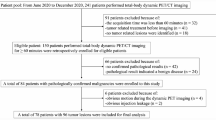Abstract
Purpose
Novel tracers for the diagnosis of malignant disease with PET and PET/CT are being developed as the most commonly used 18F deoxyglucose (FDG) tracer shows certain limitations. Employing radioactively labelled glutamate derivatives for specific imaging of the truncated citrate cycle potentially allows more specific tumour imaging. Radiation dosimetry of the novel tracer BAY 85-8050, a glutamate derivative, was calculated and the effective dose (ED) was compared with that of FDG.
Methods
Five healthy volunteers were included in the study. Attenuation-corrected whole-body PET/CT scans were performed from 0 to 90 min, at 120 and at 240 min after injection of 305.0 ± 17.6 MBq of BAY 85-8050. Organs with moderate to high uptake at any of the imaging time points were used as source organs. Total activity in each organ at each time point was measured. Time–activity curves (TAC) were determined for the whole body and all source organs. The resulting TACs were fitted to exponential equations and accumulated activities were determined. OLINDA/EXM software was used to calculate individual organ doses and the whole-body ED from the acquired data.
Results
Uptake of the tracer was highest in the kidneys due to renal excretion of the tracer, followed by the pancreas, heart wall and osteogenic cells. The mean organ doses were: kidneys 38.4 ± 11.2 μSv/MBq, pancreas 23.2 ± 3.8 μSv/MBq, heart wall 17.4 ± 4.1 μSv/MBq, and osteogenic cells 13.6 ± 3.5 μSv/MBq. The calculated ED was 8.9 ± 1.5 μSv/MBq.
Conclusion
Based on the distribution and dose estimates, the calculated radiation dose of BAY 85-8050 is 2.67 ± 0.45 mSv at a patient dose of 300 MBq, which compares favourably with the radiation dose of FDG (5.7 mSv).




Similar content being viewed by others
References
Fletcher JW, Djulbegovic B, Soares HP, Siegel BA, Lowe VJ, Lyman GH, et al. Recommendations on the use of 18F-FDG PET in oncology. J Nucl Med. 2008;49:480–508.
Czernin J, Allen-Auerbach M, Schelbert HR. Improvements in cancer staging with PET/CT: literature-based evidence as of September 2006. J Nucl Med. 2007;48:78S–88S.
Bar-Shalom R, Yefremov N, Guralnik L, Gaitini D, Frenkel A, Kuten A, et al. Clinical performance of PET/CT in evaluation of cancer: additional value for diagnostic imaging and patient management. J Nucl Med. 2003;44:1200–9.
Shreve PD, Anzai Y, Wahl RL. Pitfalls in oncologic diagnosis with FDG PET imaging: physiologic and benign variants. Radiographics. 1999;19:61–77.
Medina MÁ. Glutamine and cancer. J Nutr. 2001;131:2539S–42S.
Krasikova RN, Kuznetsova OF, Fedorova OS, Belokon YN, Maleev VI, Mu L, et al. 4-[(18)F]fluoroglutamic acid (BAY 85-8050), a new amino acid radiotracer for PET imaging of tumors: synthesis and in vitro characterization. J Med Chem. 2011;54:406–10.
Souba WW. Glutamine and cancer. Ann Surg. 1993;218(6):713–28.
Koglin N, Friebe M, Berndt M, Graham K, Krasikova R, Kuznetsova O, et al. [F-18]BAY 85-8050: a novel tumor specific probe for PET imaging – preclinical results. J Nucl Med. 2010;51 Suppl 2:1535.
Stabin MG. Uncertainties in internal dose calculations for radiopharmaceuticals. J Nucl Med. 2008;49:853–60.
Loevinger R, Budinger TF, Watson EE. MIRD primer for absorbed dose calculations. New York: The Society of Nuclear Medicine; 1991.
Jakoby B, Long M, Carr C, Townsend D. Physical performance of a new combined PET/CT scanner. J Nucl Med. 2007;48 Suppl 2:46P.
Janssen I, Heymsfield SB, Wang Z, Ross R. Skeletal muscle mass and distribution in 468 men and women aged 18–88 yr. J Appl Physiol. 2000;89:81–8.
Shen S, DeNardo GL, Sgouros G, O'Donnell RT, DeNardo SJ. Practical determination of patient-specific marrow dose using radioactivity concentration in blood and body. J Nucl Med. 1999;40:2102–6.
Stabin MG, Sparks RB, Crowe E. OLINDA/EXM: the second-generation personal computer software for internal dose assessment in nuclear medicine. J Nucl Med. 2005;46:1023–7.
International Commission on Radiological Protection. Radiation dose to patients from radiopharmaceuticals. Oxford: Pergamon; 1998. ICRP Publication 80: Addendum 2 to Publication 53.
Vesselle H, Grierson J, Peterson LM, Muzi M, Mankoff DA, Krohn KA. 18F-Fluorothymidine radiation dosimetry in human PET imaging studies. J Nucl Med. 2003;44:1482–8.
Pauleit D, Floeth F, Herzog H, Hamacher K, Tellmann L, Müller HW, et al. Whole-body distribution and dosimetry of O-(2-[18F]fluoroethyl)-L-tyrosine. Eur J Nucl Med Mol Imaging. 2003;30:519–24.
Acknowledgments
We would like to thank Yvonne Fischer and Sylvia Schachoff for their assistance with this study. The study was sponsored by BayerPharma AG.
Conflicts of interest
Claudia Bacher-Stier and Lüder Fels are employees of Bayer HealthCare, the sponsor of the study.
Ludger Dinkelborg is employed as Managing Director of Piramal Imaging GmbH.
Author information
Authors and Affiliations
Corresponding author
Rights and permissions
About this article
Cite this article
Smolarz, K., Krause, B.J., Graner, F.P. et al. Biodistribution and radiation dosimetry in healthy volunteers of a novel tumour-specific probe for PET/CT imaging: BAY 85-8050. Eur J Nucl Med Mol Imaging 40, 1861–1868 (2013). https://doi.org/10.1007/s00259-013-2502-z
Received:
Accepted:
Published:
Issue Date:
DOI: https://doi.org/10.1007/s00259-013-2502-z




